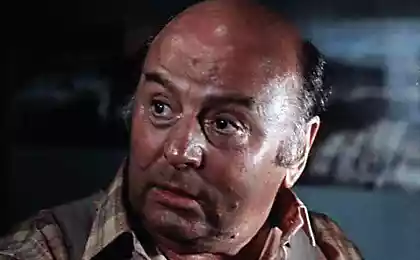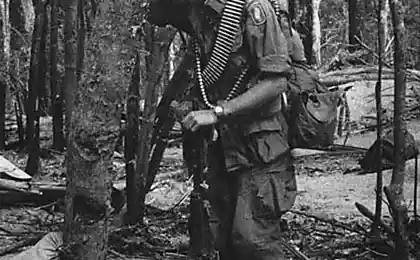2678
As he fought the Viet Cong
"Once it started to rain and did not stop for four months. During this time we learned all kinds of rain: rain straight, slanting rain, horizontal rain, and even the rain that comes from the bottom up »
In these specific circumstances, when even a few dirt roads become impassable in the mess, and the use of aviation problematic technical superiority of the US military to some extent offset by the Vietnamese and traps are very effective and deadly.

Here are some of them.
The famous trap Punji

Installed in a variety of forest trails around US bases, and being disguised under a thin layer of grass, leaves, soil or water, was difficult detectable. The size of the trap was designed just below the foot in the shoe. The stakes are always lubricated feces, carrion and other bad substances. Getting a foot in the trap, breaking through the soles of the stakes and wounding almost certainly caused a blood infection. Often have a more complex structure.

Punched shoes
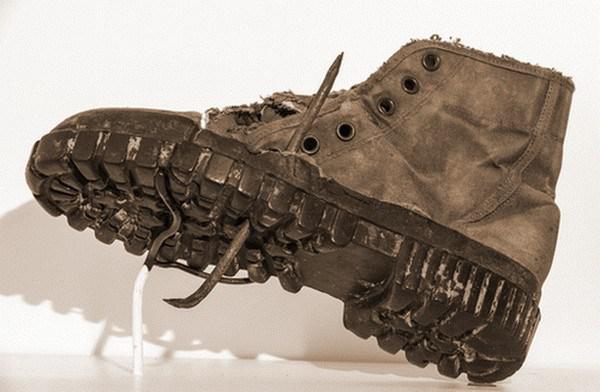
Traps Bamboo
Installed in the doors of rural houses. Should open the door, took off from a small opening a log with sharp sticks. Often the trap was set so that the impact has on the head - with a successful activation, this led to serious injury, often fatal.

Sometimes these traps, but in the form of large logs with stakes and response mechanism with stretching, installed on the trails in the jungle.
In the dense thickets of timber was replaced by a spherical structure. It should be noted that the stakes Vietnamese often did not metal, and bamboo - a very hard material, from which in Southeast Asia make knives.

Traps Whip Trap (Trap-whip)
Often installed on the trails in the jungle. To do this, the trunk of bamboo bends with long sticks at the ends and through the unit is connected with a banner. Should touch the wire or fishing line (its Vietnamese often used) and the released trunk with bamboo sticks hit with full force in the area from the knees to the stomach zadevshego. Naturally, all the traps carefully camouflaged.


Most Punji
Enlarged version Punji. Wounds inflicted this trap far more serious - here already to pierce the leg-thigh, including the groin, often with irreversible injuries to the "main male organ." The stakes are also lubricated with something bad.

One of the worst big Punji - with a rotating lid. The lid was fixed on a bamboo trunk and rotate freely, always returning to the horizontal position. On both sides of the lid was covered with grass, leaves. Stepping on the platform cover, the victim was falling into a deep hole (3 meters or more) with stakes, cover rotates through 180 degrees and the trap was again ready for the next victim.
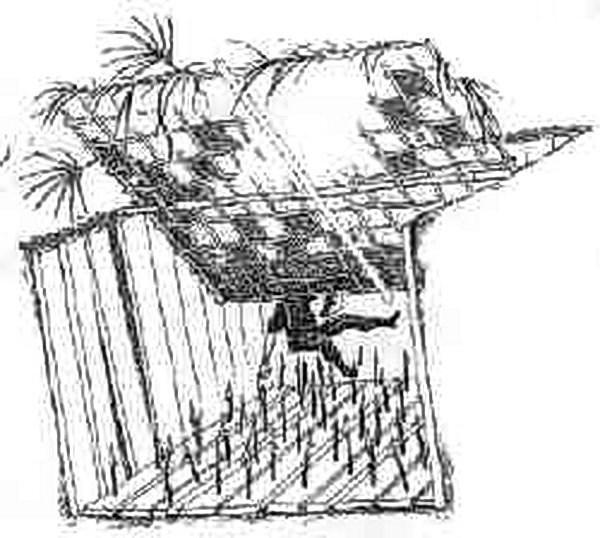
Traps Bucket Trap (Trap-bucket)
Bucket with sticks, and often with big fish hooks, digged in the earth, disguised. The full horror of this trap was that the stakes firmly fastened in the bucket at an angle down, and when released into the trap leg was impossible to get - when you try to pull it out of the bucket pins only dug deeper in the leg. So they had to dig up the bucket, and the accident, along with a bucket on his leg, evacuate using a MEDEVAC to a hospital.
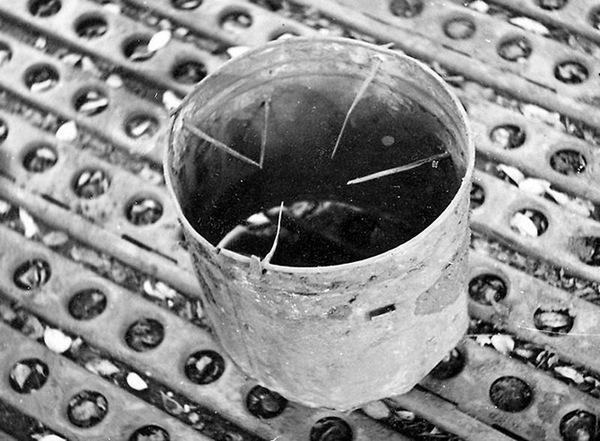
Traps Side Closing Trap (Trap with lockable parties)
Two boards with sticks held together with rubber elastic, stretched between them inserts a thin bamboo sticks. Should fall into such a trap, breaking sticks as sash slammed just at the level of the abdomen of the victim. At the bottom of the pit could also be dug additional stakes.

Traps Spike Board (snake board)
These traps are usually installed in shallow ponds, swamps, puddles, etc. Should step on the pressure plate - and the other end of the board to force clubs to beat up and away come. Successful operation often resulted in death.

Vietnamese mass production traps

Trap cartridge push action in a bamboo container. Could use different cartridges, including hunting with lead shot or buckshot.
While all of these traps and look impressive, of course, the damage from them pales in comparison with mines and grenades on extensions. Constantly mining area and placing banners, the Vietnamese managed to transform the US military presence in the opponent's ground for them in hell.

«Pineapple» (pineapple) - grenades, explosive shells and other munitions, hanging on the branches of trees. To fire had hurt branches. One of the most common traps during the Vietnam War.

Stretching - installed on the ground or close to it. The situation was aggravated by the fact that the forest floor of the jungle, in the dim light, notice the trap is very difficult, and even more so when sorokogradusnoy heat and absolute humidity, is clearly not conducive to concentration.
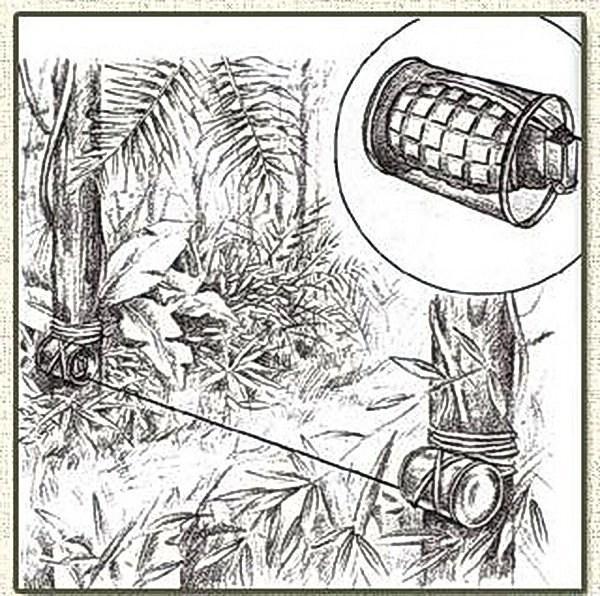
In the photo from Vietnam - a well established stretching from the Chinese hand grenade in the grass. Even in a flash from the camera it is very difficult to notice.

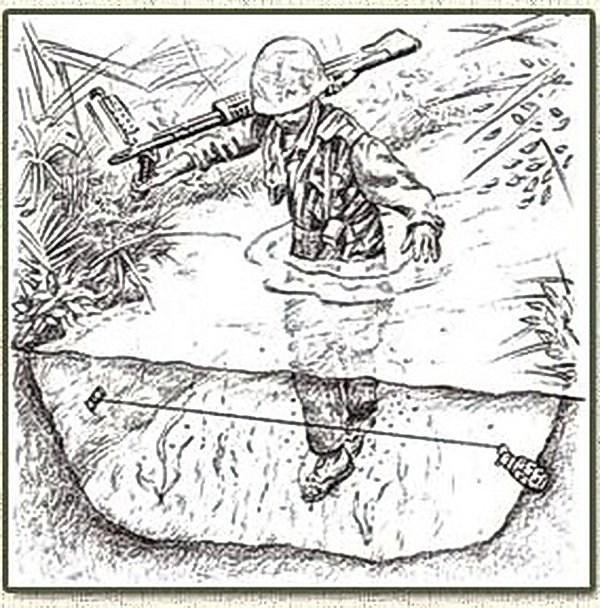
The explosion of ammunition on the basis of the Marines as a result of sabotage. Vietnam. March 18, 1968

To trap did not come across in their Vietnamese have developed a signal system of arranged
Signs of traps in a certain way of sticks, leaves and broken branches. Experienced person to these marks could determine not only that the next set a trap, but the type of the trap.
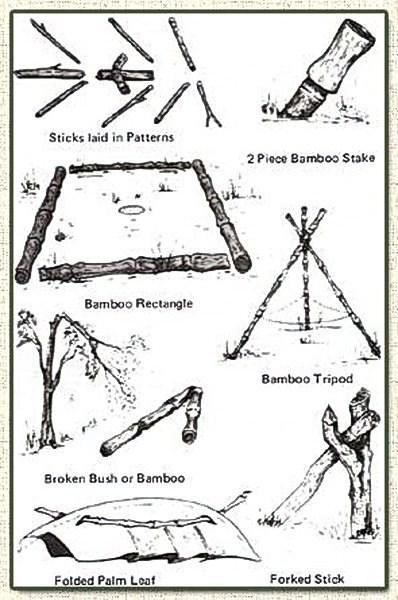
We can not say that the Americans did not fight with it. Traps and signaling system have been studied thoroughly and continuously. With staff held regular classes, published a pocket guide on traps and their disposal. Led groups began to put miners.

Disarm Trap
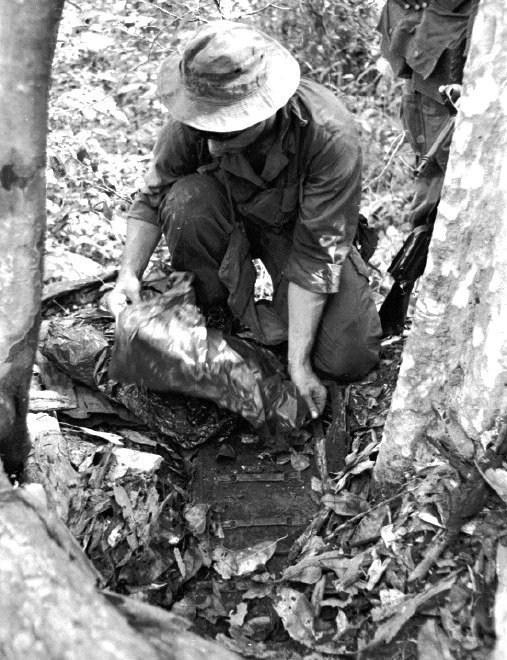
In these specific circumstances, when even a few dirt roads become impassable in the mess, and the use of aviation problematic technical superiority of the US military to some extent offset by the Vietnamese and traps are very effective and deadly.

Here are some of them.
The famous trap Punji

Installed in a variety of forest trails around US bases, and being disguised under a thin layer of grass, leaves, soil or water, was difficult detectable. The size of the trap was designed just below the foot in the shoe. The stakes are always lubricated feces, carrion and other bad substances. Getting a foot in the trap, breaking through the soles of the stakes and wounding almost certainly caused a blood infection. Often have a more complex structure.

Punched shoes

Traps Bamboo
Installed in the doors of rural houses. Should open the door, took off from a small opening a log with sharp sticks. Often the trap was set so that the impact has on the head - with a successful activation, this led to serious injury, often fatal.

Sometimes these traps, but in the form of large logs with stakes and response mechanism with stretching, installed on the trails in the jungle.
In the dense thickets of timber was replaced by a spherical structure. It should be noted that the stakes Vietnamese often did not metal, and bamboo - a very hard material, from which in Southeast Asia make knives.

Traps Whip Trap (Trap-whip)
Often installed on the trails in the jungle. To do this, the trunk of bamboo bends with long sticks at the ends and through the unit is connected with a banner. Should touch the wire or fishing line (its Vietnamese often used) and the released trunk with bamboo sticks hit with full force in the area from the knees to the stomach zadevshego. Naturally, all the traps carefully camouflaged.


Most Punji
Enlarged version Punji. Wounds inflicted this trap far more serious - here already to pierce the leg-thigh, including the groin, often with irreversible injuries to the "main male organ." The stakes are also lubricated with something bad.

One of the worst big Punji - with a rotating lid. The lid was fixed on a bamboo trunk and rotate freely, always returning to the horizontal position. On both sides of the lid was covered with grass, leaves. Stepping on the platform cover, the victim was falling into a deep hole (3 meters or more) with stakes, cover rotates through 180 degrees and the trap was again ready for the next victim.

Traps Bucket Trap (Trap-bucket)
Bucket with sticks, and often with big fish hooks, digged in the earth, disguised. The full horror of this trap was that the stakes firmly fastened in the bucket at an angle down, and when released into the trap leg was impossible to get - when you try to pull it out of the bucket pins only dug deeper in the leg. So they had to dig up the bucket, and the accident, along with a bucket on his leg, evacuate using a MEDEVAC to a hospital.

Traps Side Closing Trap (Trap with lockable parties)
Two boards with sticks held together with rubber elastic, stretched between them inserts a thin bamboo sticks. Should fall into such a trap, breaking sticks as sash slammed just at the level of the abdomen of the victim. At the bottom of the pit could also be dug additional stakes.

Traps Spike Board (snake board)
These traps are usually installed in shallow ponds, swamps, puddles, etc. Should step on the pressure plate - and the other end of the board to force clubs to beat up and away come. Successful operation often resulted in death.

Vietnamese mass production traps

Trap cartridge push action in a bamboo container. Could use different cartridges, including hunting with lead shot or buckshot.
While all of these traps and look impressive, of course, the damage from them pales in comparison with mines and grenades on extensions. Constantly mining area and placing banners, the Vietnamese managed to transform the US military presence in the opponent's ground for them in hell.

«Pineapple» (pineapple) - grenades, explosive shells and other munitions, hanging on the branches of trees. To fire had hurt branches. One of the most common traps during the Vietnam War.

Stretching - installed on the ground or close to it. The situation was aggravated by the fact that the forest floor of the jungle, in the dim light, notice the trap is very difficult, and even more so when sorokogradusnoy heat and absolute humidity, is clearly not conducive to concentration.

In the photo from Vietnam - a well established stretching from the Chinese hand grenade in the grass. Even in a flash from the camera it is very difficult to notice.


The explosion of ammunition on the basis of the Marines as a result of sabotage. Vietnam. March 18, 1968

To trap did not come across in their Vietnamese have developed a signal system of arranged
Signs of traps in a certain way of sticks, leaves and broken branches. Experienced person to these marks could determine not only that the next set a trap, but the type of the trap.

We can not say that the Americans did not fight with it. Traps and signaling system have been studied thoroughly and continuously. With staff held regular classes, published a pocket guide on traps and their disposal. Led groups began to put miners.

Disarm Trap

About American schoolgirl may prevent a war between the USSR
Million rubles as a gift Donetsk Opera and Ballet Theatre




